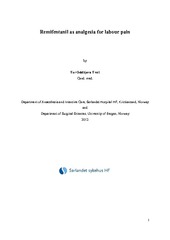Remifentanil as analgesia for labour pain
Doctoral thesis
Permanent lenke
https://hdl.handle.net/1956/6584Utgivelsesdato
2013-04-18Metadata
Vis full innførselSamlinger
Sammendrag
Aims: To collect updated information about pharmacological labour analgesia in Norway, especially systemic opioids and epidural. Evaluation of efficacy and safety with remifentanil IVPCA (intravenous patient-controlled analgesia) for pain relief during labour. To compare remifentanil IVPCAwith epidural analgesia (EDA) regarding efficacy and safety during labour. Methods: In paper I, two national surveys identified Norwegian labour analgesia methods and changes during the study period (2005-2008). Paper II is a prospective, observational study of analgesic efficacy and safety with remifentanil IVPCA. Paper III is a prospective, randomized controlled trial comparing remifentanil IVPCA with EDA regarding analgesic efficacy and safety. Results: The surveys in paper I found the frequency of EDA in Norwegian hospitals to be increasing, but still low (25.9%) compared to other western countries. Nitrous oxide and traditional systemic opioids, like pethidine, were frequently used. In paper II remifentanil IVPCA was found to give satisfactory labour analgesia in more than 90% of the parturients with an average maximal pain reduction of 60%. Maternal oxygen desaturation and sedation were acceptable, and neonatal data reassuring. In paper III, a randomized controlled trial found remifentanil IVPCA and EDA to be comparable both regarding analgesic efficacy (pain reduction) and maternal satisfaction. Remifentanil IVPCA produced more maternal sedation and oxygen desaturation, neonatal outcome was reassuring in both groups. Conclusions: The frequency of epidural labour analgesia in Norway has increased, but is still relatively low. Nitrous oxide and traditional systemic opioids are frequently used. The clinical practice seems conservative, newer short-acting opioids are seldom used for systemic labour analgesia. The studies on remifentanil IVPCA revealed adequate pain relief, high maternal satisfaction, and no serious neonatal side effects. There were no differences in analgesic efficacy, maternal satisfaction, and neonatal outcome when comparing remifentanil IVPCA with EDA. However, remifentanil caused maternal sedation and oxygen desaturation. We recommend the use of IVPCA remifentanil as labour analgesia instead of traditional opioids as pethidine and morphine when EDA is not an option. The presence of skilled personnel and close monitoring is mandatory.
Består av
Paper I: Tveit, T. O., Halvorsen, A. & Rosland, J. H. (2009) Analgesia for labour: a survey of Norwegian practice – with focus on parenteral opioids. Acta Anaesthesiologica Scandinavica 53(6): 794–799, July 2009. Full text not available in BORA due to publisher restrictions. The article is available at: http://dx.doi.org/10.1111/j.1399-6576.2009.01988.xPaper II: Tveit, T. O., Halvorsen, A., Seiler, S. & Rosland, J. H. (2013) Efficacy and side effects of intravenous remifentanil patient-controlled analgesia used in a stepwise approach for labour: an observational study. International Journal of Obstetric Anesthesia 22(1): 19–25, January 2013. Full text not available in BORA due to publisher restrictions. The article is available at: http://dx.doi.org/10.1016/j.ijoa.2012.09.003
Paper III: Tveit, T. O., Seiler, S., Halvorsen, A. & Rosland, J. H. (2012) Labour analgesia: a randomized, controlled trial comparing intravenous remifentanil and epidural with ropivacain and fentanyl. European Journal of Anaesthesiology 29(3): 129-136, March 2012. Full text not available in BORA due to publisher restrictions. The article is available at: http://dx.doi.org/10.1097/EJA.0b013e32834dfa98
